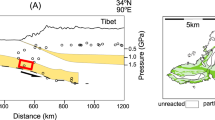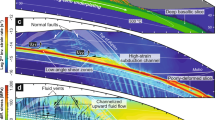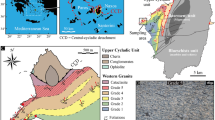Abstract
The feedback between fluid migration and rock deformation in mid-crustal shear zones is acknowledged as being critical for earthquake nucleation, the initiation of subduction zones and the formation of mineral deposits1,2,3. The importance of this poorly understood feedback is further highlighted by evidence for shear-zone-controlled advective flow of fluids in the ductile lower crust4 and the recognition that deformation-induced grain-scale porosity is a key to large-scale geodynamics5,6. Fluid migration in the middle crust cannot be explained in terms of classical concepts. The environment is considered too hot for a dynamic fracture-sustained permeability as in the upper crust7, and fluid pathways are generally too deformed to be controlled by equilibrium wetting angles that apply to hotter, deeper environments8,9,10. Here we present evidence that mechanical and chemical potentials control a syndeformational porosity generation in mid-crustal shear zones. High-resolution synchrotron X-ray tomography and scanning electron microscopy observations allow us to formulate a model for fluid migration in shear zones where a permeable porosity is dynamically created by viscous grain-boundary sliding, creep cavitation, dissolution and precipitation. We propose that syndeformational fluid migration in our ‘granular fluid pump’ model is a self-sustained process controlled by the explicit role of the rate of entropy production of the underlying irreversible mechanical and chemical microprocesses. The model explains fluid transfer through the middle crust, where strain localization in the creep regime is required for plate tectonics, the formation of giant ore deposits, mantle degassing and earthquake nucleation. Our findings provide a key component for the understanding of creep instabilities in the middle crust.
This is a preview of subscription content, access via your institution
Access options
Subscribe to this journal
Receive 51 print issues and online access
$199.00 per year
only $3.90 per issue
Buy this article
- Purchase on Springer Link
- Instant access to full article PDF
Prices may be subject to local taxes which are calculated during checkout




Similar content being viewed by others
References
Sibson, R. Crustal stress, faulting and fluid flow. Spec. Publ. Geol. Soc. (Lond.) 78, 69–84 (1994)
Regenauer-Lieb, K., Yuen, D. A. & Branlund, J. The initiation of subduction: criticality by addition of water? Science 294, 578–580 (2001)
Kolb, J. The role of fluids in partitioning brittle deformation and ductile creep in auriferous shear zones between 500 and 700 °C. Tectonophysics 446, 1–15 (2008)
Mack Kennedey, B. & van Soest, M. C. Flow of mantle fluids through the ductile lower crust. Science 318, 1433–1436 (2007)
Regenauer-Lieb, K. Dilatant plasticity applied to Alpine collision: ductile void growth in the intraplate area beneath the Eifel volcanic field. Geodynamics 27, 1–21 (1999)
Bercovici, D. Generation of plate tectonics from lithosphere-mantle flow and void-volatile self-lubrication. Earth Planet. Sci. Lett. 154, 139–151 (1998)
Cox, S. F. & Etheridge, M. A. Coupled grain-scale dilatancy and mass transfer during deformation at high fluid pressures: examples from Mount Lyell, Tasmania. J. Struct. Geol. 11, 147–162 (1989)
Watson, E. B. & Brenan, J. M. Fluids in the lithosphere. 1. Experimentally-determined wetting characteristics of CO2–H2O fluids and their implications for fluid transport, host-rock physical properties, and fluid inclusion formation. Earth Planet. Sci. Lett. 85, 497–515 (1987)
Holness, M. How melted rocks migrate. Science 314, 934–935 (2006)
Kohlstedt, D. L. & Holtzman, B. K. Shearing melt out of the Earth: an experimentalist’s perspective on the influence of deformation on melt extraction. Annu. Rev. Earth Planet. Sci. 37, 1–33 (2009)
Fusseis, F. & Handy, M. R. Micromechanisms of shear zone propagation at the brittle-ductile transition. J. Struct. Geol. 30, 1242–1253 (2008)
Fliervoet, T., White, S. H. & Drury, M. R. Evidence for dominant grain-boundary sliding deformation in greenschist- and amphibolite-grade polymineralic ultramylonites from the Redbank Deformed Zone, Central Australia. J. Struct. Geology 19, 1495–1520 (1997)
White, S. et al. On mylonites in ductile shear zones. J. Struct. Geol. 2, 175–187 (1980)
Wang, Y. et al. A high-throughput X-ray microtomography system at the Advanced Photon Source. Rev. Sci. Instrum. 72, 2062–2068 (2001)
O’Hara, K. & Blackburn, W. H. Volume-loss model for trace-element enrichments in mylonites. Geology 17, 524–527 (1989)
Wintsch, R. P. & Yi, K. Dissolution and replacement creep: a significant deformation mechanism in mid-crustal rocks. J. Struct. Geol. 24, 1179–1193 (2002)
Kruse, R. & Stünitz, H. Deformation mechanism and phase distribution in mafic high-temperature mylonites from the Jotun Nappe, southern Norway. Tectonophysics 303, 223–249 (1999)
Blanchard, C. R. & Chan, K. S. Evidence of grain boundary-sliding-induced cavitation in ceramics under compression. J. Am. Ceram. Soc. 76, 1651–1660 (1993)
Kassner, M. E. & Hayes, T. A. Creep cavitation in metals. Int. J. Plast. 19, 1715–1748 (2003)
Mitra, G. Ductile deformation zones and mylonites: the mechanical processes involved in the deformation of crystalline basement rocks. Am. J. Sci. 278, 1057–1084 (1978)
Atkinson, B. K. Subcritical crack propagation in rocks: theory, experimental results and applications. J. Struct. Geol. 4, 41–56 (1982)
Paterson, M. S. in Superplasticity in Metals, Ceramics, and Intermetallics (eds Mayo, M. J., Kobayashi, M. & Wadsworth, J.) 303–312 (MPR Symp. Proc. 196, Materials Research Society, 1990)
Hiraga, T., Nagase, T. & Akizuki, M. The structure of grain boundaries in granite-origin ultramylonite studied by high-resolution electron microscopy. Phys. Chem. Miner. 26, 617–623 (1999)
Shigematsu, N., Fujimoto, K., Ohtani, T. & Goto, K. Ductile fracture of fine-grained plagioclase in the brittle-plastic transition regime: implication for earthquake source nucleation. Earth Planet. Sci. Lett. 222, 1007–1022 (2004)
Rybacki, E., Wirth, R. & Dresen, G. High-strain creep of feldspar rocks: Implications for cavitation and ductile failure in the lower crust. Geophys. Res. Lett. 35, L04304 (2008)
Tullis, J., Yund, R. & Farver, J. Deformation-enhanced fluid distribution in feldspar aggregates and implications for ductile shear zones. Geology 24, 63–66 (1996)
Wark, D. A. & Watson, E. B. Effect of grain size on the distribution and transport of deep-seated fluids and melts. Geophys. Res. Lett. 27, 2029–2032 (2000)
Regenauer-Lieb, K., Yuen, D. A. & Fusseis, F. Landslides, ice quakes, earthquakes: a thermodynamic approach to surface instabilities. Pure Appl. Geophys (in the press)
Etheridge, M. A., Wall, V. J. & Vernon, R. H. The role of the fluid phase during regional metamorphism and deformation. J. Metamorph. Geol. 1, 205–226 (1983)
Chokshi, A. H. Cavity nucleation and growth in superplasticity. Mater. Sci. Eng. A 410–411, 95–99 (2005)
Acknowledgements
This work was supported by the Australian Synchrotron Research Program, which is funded by the Commonwealth of Australia under the Major National Research Facilities Program. Use of the Advanced Photon Source at Argonne National Laboratory was supported by the US Department of Energy, Office of Science, Office of Basic Energy Sciences, under contract number DE-AC02-06CH11357. The work was supported by iVEC through the use of visualization resources and expertise provided by the WASP and ARRC facilities. We acknowledge the Centre for Microscopy, Characterization and Analysis at the University of Western Australia for the use of its FESEM. Our work was financially supported by the Western Australian Premier’s Research Fellowship program and the University of Western Australia through a research grant. The Multiscale Earth System Dynamics group as well as H. Stuenitz, R. Heilbronner and D. Healy participated in discussions. C. Schrank assisted with data processing.
Author Contributions F.F. did the field work, the FESEM analyses and part of the synchrotron experiment, interpreted the data and co-wrote the paper. K.R.-L. designed the study and co-wrote the paper. J.L. processed and analysed the tomographic data. R.M.H. designed and did part of the synchrotron experiment and co-wrote the paper. F.D.C. did part of the synchrotron experiment and processed tomographic data. All authors discussed the results and commented on the paper.
Author information
Authors and Affiliations
Corresponding author
Supplementary information
Supplementary Information
This file contains a Supplementary Discussion, Supplementary Data, Supplementary Methods, Supplementary References, Supplementary Figures 1-3 with Legends and Legends for Movies 1-2 and Supplementary Movies 1-2. (PDF 951 kb)
Movie 1
In this movie we see porosity (red, lowest absortion of X-rays), a mica phase (blue, intermediate absorption) and oxides plus epidote (yellow, high absorption), in subsample B01 from the low-strain shear zone margin ('a' in Supplementary Figure 1). See file s1 for full Legend. (MOV 33303 kb)
Movie 2
In this movie we see isosurfaces representing porosity (red, lowest absortion of X-rays), a mica phase (blue, intermediate absorption) and oxides plus epidote (yellow, high absorption), in subsample H03 from the high-strain shear zone centre ('b' in Supplementary Figure 1). See file s1 for full Legend. (MOV 32156 kb)
Supplementary Movie 1
Supplementary Movie 1 zooms into pores comprising pore sheets in about the centre of subsample H03, which is shown in Figure 3d and movie 2. See file s1 for full Legend. (MOV 12123 kb)
Supplementary Movie 2
Supplementary Movie 2 zooms into pores forming an intracrystalline porous skeleton in a plagioclase clast in the peripheral low-strain sample J01. See file s1 for full Legend. (MOV 17080 kb)
Rights and permissions
About this article
Cite this article
Fusseis, F., Regenauer-Lieb, K., Liu, J. et al. Creep cavitation can establish a dynamic granular fluid pump in ductile shear zones. Nature 459, 974–977 (2009). https://doi.org/10.1038/nature08051
Received:
Accepted:
Issue Date:
DOI: https://doi.org/10.1038/nature08051
This article is cited by
-
Strain Localized Deformation Variation of a Small-Scale Ductile Shear Zone
Journal of Earth Science (2023)
-
Ductile deformation during carbonation of serpentinized peridotite
Nature Communications (2022)
-
The impact of melt versus mechanical wear on the formation of pseudotachylyte veins in accretionary complexes
Scientific Reports (2022)
-
Porosity induced by dislocation dynamics in quartz-rich shear bands of granitic rocks
Scientific Reports (2022)
-
Reactive fluid flow guided by grain-scale equilibrium reactions during eclogitization of dry crustal rocks
Contributions to Mineralogy and Petrology (2022)
Comments
By submitting a comment you agree to abide by our Terms and Community Guidelines. If you find something abusive or that does not comply with our terms or guidelines please flag it as inappropriate.



